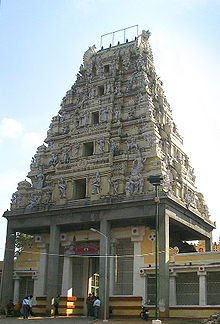Nandi Temple


Dodda Basavana Gudi (the Nandi Temple) is situated in Bull Temple Road, Basavanagudi, area of South Bangalore, part of the largest city of the Indian state of Karnataka. The Hindu temple is inside a park called Bugle Rock.
The bull referred to is a sacred Hindu demi-god, known as Nandi; Nandi is a close devotee and attendant of Shiva. Dodda Basavana Gudi is said to be the biggest temple to Nandi in the world. The stone cult image of Nandi is continually covered with new layers of butter, benne in the local language of Kannada. There is a cult image of the elephant-headed Hindu deity son of shiva Ganesha close by.
Every year on the last Monday and Tuesday of the Hindu month of Karthika Maasa a groundnut fair is held in the Nandi Temple premises and groundnut is offered to the deity. This fair is known as 'Kadalekaayi Parishe' in local tongue. Groundnut sellers and devotees throng the place during Kadalekaayi Parishe.
Basavana Gudi is a regular place of visit for tourists and is covered by most of the tour operators including the Karnataka State Tourism Development Corporation.
Nandi Temple is exclusively for the worship of the sacred bull (Basava in Kannada) in Hinduism, known as Nandi, Lord Shiva's vahana. The word "nandi" means "joyful" in Sanskrit.
The Nandi Temple was built in 1537 by Kempe Gowda under the Vijayanagara empire in the Vijayanagara architectural style, he also founded the city of Bangalore. The temple is named after the large granite Nandi monolith placed on a plinth in the temple shrine (garbhagriha) which has become blackened from years of being rubbed with charcoal and oil. The temple is a small one, consisting only of the shrine fronted by a porch in the Vijayanagara style. The current tower (vimana) over the shrine was constructed in the early 20th century and is adorned with Saivite figures and motifs.
It is said to house one of the largest Nandi murthis in the world. The height of the murthi is approximately 15 ft (4.6 m) and it is approximately 20 feet (6.1 m) long